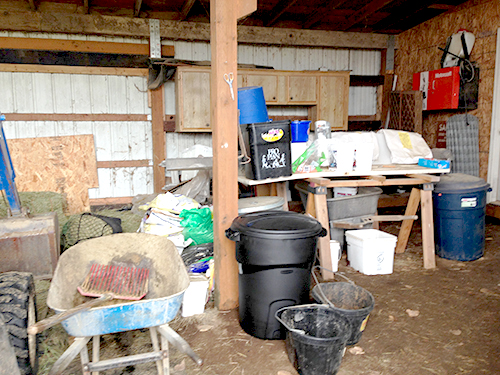Spring Cleaning – Disinfect Your Barn and Maintain a Healthy Environment
by Dave Sauter, DVM
 With spring in the air and a “fresh start” on everyone’s mind, there’s no better time to talk about disinfecting your horse facility. Whether talking about a surgical instrument, hospital room, horse stall, trailer or barn implement, the principals are the same. Done properly, disinfecting will eliminate infectious material and reduce the spread of contagious diseases such as strangles, salmonella, rota virus, influenza, and EHV-1, to name a few. Done improperly it gives a false sense of security and can even make matters worse, resulting in an increase in the spread of disease.
With spring in the air and a “fresh start” on everyone’s mind, there’s no better time to talk about disinfecting your horse facility. Whether talking about a surgical instrument, hospital room, horse stall, trailer or barn implement, the principals are the same. Done properly, disinfecting will eliminate infectious material and reduce the spread of contagious diseases such as strangles, salmonella, rota virus, influenza, and EHV-1, to name a few. Done improperly it gives a false sense of security and can even make matters worse, resulting in an increase in the spread of disease.
In order for disinfecting to be successful, a critically important step must take place first—cleaning. Cleaning and disinfecting are separate processes. The purpose of cleaning is to remove organic material, whereas the disinfectant kills microorganisms. Dirt and organic material, such as manure, pus, blood, soil, and plant material, interfere with disinfectants in two ways. First, for disinfectants to do the job of killing bacteria, the disinfectant has to make contact with the infectious agent. It can’t do that if there is organic material creating a physical barrier (e.g. clod of manure) between the infectious agent and the disinfectant. Second, disinfectants are, to varying degrees, inactivated by organic material, thereby losing their ability to kill. Bleach is a good example of a disinfectant that is much less effective in the presence of organic material.
Cleaning can be divided into two steps: dry cleaning and wet cleaning. The dry cleaning involves physically removing everything possible, such as bedding, feed, cobwebs, and manure. Surfaces can be scraped to remove dried manure or debris. Moveable physical objects such as buckets and floor mats can be taken outside to have the same sequence of cleaning and disinfecting. Sweep everything clean, starting high with ceilings, light fixtures, window sills, etc. and work your way down the walls to the floor. Don’t forget buckets, feed tubs, shovels, pitchforks, grooming equipment, vehicles, clothing, etc. Water and either soap or a detergent is used next to thoroughly soak, scrub and wash all surfaces. No one said this was easy! It is very important to thoroughly rinse since soap and detergent can interfere with disinfectants and they can harm horses. Start from the top down and from the inside out, whether in a stall, trailer or other structure.
After the rinsing, the final cleaning step is drying. Drying should occur rapidly and thoroughly, otherwise the moisture might result in an increase in bacterial levels. Since drying is so important, consider the weather and time of day when starting the cleaning process. Thorough cleaning can eliminate upwards of 90% of the bacteria. Pressure washers can sure help clean surfaces but they also aerosolize pathogens, blasting them into the air and all over the place. They should only be used if the building they are used in is going to be vacated during the cleaning and for a couple weeks afterwards.
Once the drying is complete the disinfectant can be applied. There are at least ten categories of disinfectants, with different spectrums of activity against different types of microorganisms, toxicity, contact times, effectiveness in the presence of organic material, and causticity. Phenolic disinfectants are a good choice for horse barns because they are broad spectrum and work better than others with organic material present, but they are more caustic. Check the expiration date of the product, read the warnings and wear the recommended protective clothing and eye goggles. Do not mix chemicals. Anything horses are going to eat or drink from should be thoroughly rinsed after the disinfectant has dried.
While we’re on the subject of disease prevention, let’s not forget some of the basics. These include a vaccination plan appropriate to your area (keep records of these!), a de-worming schedule using fecal exams as a guide, protection of hay/grain from wildlife, isolation of new/sick horses (keep your clothing, footwear, and barn implements separate, too), and make sure ALL horses are trained to have their temperatures taken safely, regularly, whenever and by whoever.
Although disinfecting is a useful tool in reducing the spread of infectious disease, keeping a clean and tidy barn can go a long way toward the same goal of keeping a healthy environment.

Dave Sauter is a Minnesota native and graduated from the University of Minnesota in 1987. Following graduation he interned at Rood and Riddle Equine Hospital in Lexington, Kentucky. After this internship, he continued to work exclusively with horses for another five years in Kentucky before moving out West and joining Kulshan Veterinary Hospital in Lynden, WA. He is a member of the AAEP, AVMA and the WSVMA. For more information about Kulshan Veterinary Hospital call 360-354-5095 or email [email protected]. www.KulshanVet.com






